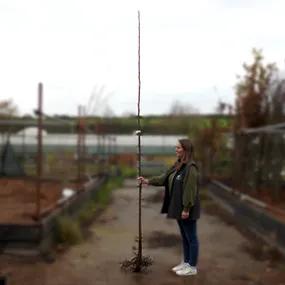Black Walnut, Large Trees
Honest Delivery Prices- Quality nuts, excellent timber.
- Sizes: Standards & Saplings
- Max Height: 30m
- RHS Award of Garden Merit
- Bareroot Delivery: Nov-Mar
Recommended extras
Description
Juglans nigra: Bareroot Black Walnut Trees in Standard Sizes
The Black Walnut, Juglans nigra, is a large, fast-growing deciduous tree with distinctive ridged bark and fragrant leaves that turn butter yellow in autumn.
It produces an abundance of nuts in the autumn: you will know that they are ready when you see lots of squirrels around your tree! The nuts are notoriously messy to remove from their husks, but the quality of the kernel is considered to be better than the common walnut that you normally see in the shops.
They are vigorous and can reach a height of about 30 metres in the British climate.
Standard trees are the largest size that we deliver; we also sell younger Black Walnut saplings as well as Common Walnut trees.
Browse our ranges of nut trees or fruit trees.
Delivery season: Walnut trees are delivered bareroot during late autumn and winter, approximately November-March inclusive.
Choosing a size: Small trees are cheaper, easier to handle and more forgiving of less than ideal aftercare, so they are best for a big planting project. If instant impact is your priority, or if you are only buying a few plants for use in a place where it is convenient to water them well in their first year, then you may as well use bigger ones. All our bareroot trees are measured by their height in centimetres above the ground (the roots aren't measured).
Features:
- Height: 30m
- Soil: Any fertile, deep and well drained
- Use: Parkland,
- Colour: Butter yellow Autumn leaves
- Not recommended for the North & Scotland
- RHS Award of Garden Merit
- Bareroot delivery only: November-March
Growing Black Walnut Trees
Suitable for any fertile, deep, well drained soil, they do need full sun. If you want good crops, a sheltered location is ideal.
To keep your tree at a relatively manageable size, the standard practice is to prune out the leading stem and maintain them as an open centred goblet.
Please note: Walnuts do not crop reliably North of about Liverpool, especially on the cooler Eastern side of the UK.
Harvesting: The nuts are perfectly ripe when you can squeeze the outer hulls with your fingers and easily leave a dent. They will start to fall of their own accord, but you can shake the tree with poles to encourage them.
Wear rubber gloves and work clothes, because they stain. Use a knife to slice around the hulls and then twist the halves in opposite directions to remove it.
Next, put the hulled nuts into a bucket of water and scrub them clean, or use a pressure hose. Discard any that float.
Dry them off (you can speed this up in a cool oven at 40B0C) and store them in mesh bags for at least four weeks. Shake the bags every day at the start to ensure that they dry really well. They are now ready to eat and will keep for about a year in a cool, dry place.
Black Walnuts are infamous for preventing many other plants from growing underneath them. Here is a list of companion plants for Black Walnut.
Planting Instructions
Notes on planting Black Walnut trees:
The Black walnut grows best in deep, well-drained soil and it likes plenty of sun. It is a bit hardier than the Common walnut, but we still don't recommend it for frosty places or the North if you plan to harvest nuts from it.
They are infamous for killing many other plants that grow near them, so we've made a list of suitable companion plants that can thrive next to one.
Prepare your site before planting:
It is good to dig over the site where you plant a tree several months in advance. Kill the weeds first: for tough weeds like nettles, brambles and ground elder, you will usually need a weed-killer to get rid of them. When you dig the soil over, remove stones and other rubbish and mix in well rotted compost or manure down to the depth of about 2 spades.
Watch our video on how to plant a tree for full instructions.
Remember to water establishing trees during dry weather for at least a year after planting.
Tree Planting accessories:
Prepare your site for planting by killing the weeds and grass.
You can buy a tree planting pack with a wooden stake & rubber tie to support the tree and a mulch mat with pegs to protect the soil around the base of your tree from weeds and drying out.
We suggest that you use mycorrhizal "friendly fungi" on the roots of all newly planted large trees: if your soil quality is poor, we strongly recommend it.
You can also improve your soil with bonemeal organic fertiliser.
Did You Know?
Black Walnuts are an American tree that was brought to Britain in the mid-1600's by John Tradescant. They are superb timber trees, and now grow wild in many parts of Southern England and Wales.
The biggest specimens in the world are around 50 metres tall, and they live for about 250 years.
Standard trees are measured by their girth in centimetres 1 metre above ground level: their trunk's waist measurement. Unlike sapling trees and hedge plants, standards aren't measured by their height, which will vary quite a bit both between and within species.
So, a 6/8cm standard tree has a trunk with a circumference of 6-8cm and an 8/10 standard has a trunk 8-10cm around. This measurement makes no difference to the tree's final height.
On average, standard trees are 2-3.5 metres tall when they arrive, but we cannot tell you precisely how tall your trees will be before we deliver them.

 1.webp)
 1.webp)
 2.webp)
 3.webp)
 4.webp)

 5.webp)